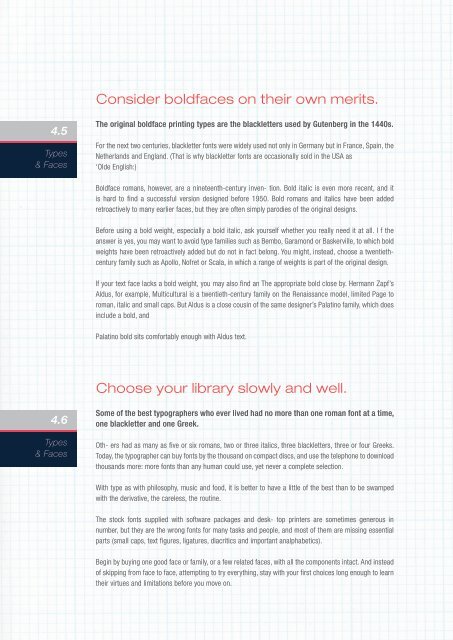5 Trick Pony Brand Guidelines v3
Create successful ePaper yourself
Turn your PDF publications into a flip-book with our unique Google optimized e-Paper software.
Consider boldfaces on their own merits.<br />
4.5<br />
Types<br />
& Faces<br />
The original boldface printing types are the blackletters used by Gutenberg in the 1440s.<br />
For the next two centuries, blackletter fonts were widely used not only in Germany but in France, Spain, the<br />
Netherlands and England. (That is why blackletter fonts are occasionally sold in the USA as<br />
‘Olde English:)<br />
Boldface romans, however, are a nineteenth-century inven- tion. Bold italic is even more recent, and it<br />
is hard to find a successful version designed before 1950. Bold romans and italics have been added<br />
retroactively to many earlier faces, but they are often simply parodies of the original designs.<br />
Before using a bold weight, especially a bold italic, ask yourself whether you really need it at all. I f the<br />
answer is yes, you may want to avoid type families such as Bembo, Garamond or Baskerville, to which bold<br />
weights have been retroactively added but do not in fact belong. You might, instead, choose a twentiethcentury<br />
family such as Apollo, Nofret or Scala, in which a range of weights is part of the original design.<br />
If your text face lacks a bold weight, you may also find an The appropriate bold close by. Hermann Zapf’s<br />
Aldus, for example, Multicultural is a twentieth-century family on the Renaissance model, limited Page to<br />
roman, italic and small caps. But Aldus is a close cousin of the same designer’s Palatino family, which does<br />
include a bold, and<br />
Palatino bold sits comfortably enough with Aldus text.<br />
Choose your library slowly and well.<br />
4.6<br />
Types<br />
& Faces<br />
Some of the best typographers who ever lived had no more than one roman font at a time,<br />
one blackletter and one Greek.<br />
Oth- ers had as many as five or six romans, two or three italics, three blackletters, three or four Greeks.<br />
Today, the typographer can buy fonts by the thousand on compact discs, and use the telephone to download<br />
thousands more: more fonts than any human could use, yet never a complete selection.<br />
With type as with philosophy, music and food, it is better to have a little of the best than to be swamped<br />
with the derivative, the careless, the routine.<br />
The stock fonts supplied with software packages and desk- top printers are sometimes generous in<br />
number, but they are the wrong fonts for many tasks and people, and most of them are missing essential<br />
parts (small caps, text figures, ligatures, diacritics and important analphabetics).<br />
Begin by buying one good face or family, or a few related faces, with all the components intact. And instead<br />
of skipping from face to face, attempting to try everything, stay with your first choices long enough to learn<br />
their virtues and limitations before you move on.





